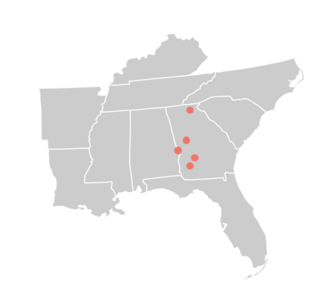
The tinfoil barb is a tropical Southeast Asian freshwater fish of the family Cyprinidae. This species was originally described as Barbus schwanenfeldii by Pieter Bleeker in 1853, and has also been placed in the genera Barbodes and Puntius. The specific epithet is frequently misspelled schwanefeldii.

The tiger barb or Sumatra barb, is a species of tropical cyprinid fish. The natural geographic range reportedly extends throughout the Malay Peninsula, Sumatra and Borneo in Indonesia, with unsubstantiated sightings reported in Cambodia. Tiger barbs are also found in many other parts of Asia, and with little reliable collection data over long periods of time, definite conclusions about their natural geographic range versus established introductions are difficult. Tiger barbs may sometimes be confused with Puntigrus anchisporus, Puntigrus navjotsodhii, or Puntigrus partipentazona, which are similar in appearance, the only differences being the slightly different stripe pattern and the number of scales these fish have.

The common dace is a species of freshwater and brackish water ray-finned fish from the family Cyprinidae which is native to Europe but which has been introduced to other parts of the world. It is a quarry species for coarse anglers.

The harlequin rasbora is a small fish in the family Cyprinidae. The species became an instant favorite among aquarists after its introduction in the early 1900s and is the best known and most widely kept species among the rasboras. In 1935, an image of a trio of harlequin rasboras, stamped in 14k gold, would grace the cover of the first edition of William T. Innes's classic Exotic Aquarium Fishes and would remain so through all 19 editions.

The southern redbelly dace, is a North American species of temperate freshwater fish of the family Cyprinidae. The natural geographic range extends from Western New York to Minnesota, and south to Oklahoma, Arkansas, and Alabama. This fish prefers flowing pools of creeks and streams.

The green labeo or mountain labeo, is a species of freshwater fish in the family Cyprinidae. It is found only in Sri Lanka, where it occurs in streams in the basin of the Mahaweli River.
The Sandhills chub is a species of freshwater fish in the family Cyprinidae of order Cypriniformes. There are 4 species of Semotilus, 2 of which occur in South Carolina. This fish is found only in North Carolina and South Carolina. The Sandhills chub is predominately found in the Carolina Sandhills and some areas of Cape Fear, Pee Dee and Santee river drainages. It is characterized by its robust body, large head and lack of a dark blotch or smudge on their dorsal fin which is present on the closely related Creek Chub. The Sandhills chub has fine scales, a pinkish body and can be up to 9.4 inches.

Percina burtoni, the blotchside logperch or blotchside darter, is a small, endangered species of freshwater ray-finned fish, a darter from the subfamily Etheostomatinae, part of the family Percidae, which also contains the perches, ruffes and pikeperches. It is endemic to the United States and classified as vulnerable on the IUCN Red List.

The flying fox is a Southeast Asian species of freshwater fish in the family Cyprinidae. It is commonly kept in the aquarium trade. Among other foods, it is known to eat green algae. It is sometimes mistakenly referred to as the Siamese algae eater.

The greater scissortail is a species of ray-finned fish in the genus Rasbora. It inhabits forest creeks in Malaysia, Indonesia and the lower Mekong basin.

The twospot rasbora is a species of ray-finned fish in the genus Rasbora native to south east asia. It is one of the members of the Sumatrana group.

Barbonymus balleroides is a species of ray-finned fish in the genus Barbonymus from south-east Asia. it is a widely eaten food fish and makes up the majority of the fish biomass in most of its range.

The Java barb, more commonly known as silver barb in aquaculture, is a species of ray-finned fish in the genus Barbonymus.
The arrow darter is a species of freshwater ray-finned fish, a darter from the subfamily Etheostomatinae, part of the family Percidae, which also contains the perches, ruffes and pikeperches. It is found in parts of Kentucky and Tennessee, particularly in the Cumberland and Kentucky Rivers. These small fish are part of the perch family. They grow to be about 4.5 inches in length. Their opercle, breast, and cheek are all unscaled. They have a vertical black bar at the base of their caudal fin. Six to nine vertical banded bars run down the side of the fish. The dorsal side of the fish is olive green in color, and the ventral side is a yellow to white pattern. The first dorsal fin has a black base, followed by green color, and then a reddish-orange end. The second dorsal is clear with two rows of laterally lined orange spots. The caudal fin is clear and has two-three vertical lines of orange spots. The anal fin has a green base and then clear at the end. The breeding male has bright orange-red spots and breeding tubercles present on the scales.

Etheostoma variatum, the variegate darter, is a species of freshwater ray-finned fish, a darter from the subfamily Etheostomatinae, part of the family Percidae, which also contains the perches, ruffes and pikeperches. It is native to the eastern United States where it occurs primarily in the Ohio River basin; it is present in the states of Ohio, New York, Pennsylvania, Indiana, West Virginia and Kentucky with a small population in Virginia. It is a large darter, growing to 10 cm (4 in) long, orange-red with black vertical barring on its body, and horizontal barring on its front dorsal fin. Its typical habitat is swift-flowing riffles with rubble, boulder and gravel. No major threats have been identified for this fish and the International Union for Conservation of Nature has assessed its conservation status as being of "least concern".
The Malabar black-backed barb is a species of fish in the family Cyprinidae in the Puntius genus. The species has been discovered in 2012, named and described by Prof. Dr. Mathews Plamoottil, Head of the Department of Zoology, Baby John Memorial Govt. College, Chavara, Kollam, Kerala in 2014. The study and paper on the fish was published in international publications like Journal of Research in Biology in December the same year (2014). It was collected from Mananthavady river in the high altitude hilly Wayanad district in Kerala, India. The specific name 'nigronotus refers to the color of the blackish back side of the fish.

The Halloween darter is a small freshwater fish native to North America. It is found in Georgia and Alabama in the drainage basin of the Apalachicola River, specifically in the Flint River system and the Chattahoochee River system. It prefers shallow, fast-flowing areas with gravel bottoms in small and medium-sized rivers. It was first described in 2008, having not previously been distinguished from the Blackbanded darter (P. nigrofasciata), formerly though to occur in the same watershed. Blackbanded darter has since been split again with Westfall's darter now recognised from the Apalachicola drainage. The species is somewhat variable, being generally blackish dorsally, with some individuals having indistinct saddle-like barring. Males have orange and dark lateral striping while females have dark stripes and a yellowish-green belly. At a maximum standard length of 101 mm (4 in), males are slightly larger than females, and both sexes develop distinctive orange barring on the edge of the first dorsal fin during the breeding season.

Rasbora vulgaris is a species of ray-finned fish in the genus Rasbora. It is a member of the R. paviana-subgroup, which comprises five species from Indochina and the Malay Peninsula
Schistura scripta, is a species of ray-finned fish in the genus Schistura, newly identified from Sri Lanka. It is the third species of Schistura stone loach described from Sri Lanka, the other being the widely distributed native species Schistura notostigma and endemic Schistura madhavai.
Clarias anfractus is a species of clariid catfish from Borneo. It is known from the Segama and Kalabakan drainages in Sabah, Northeastern Borneo.















